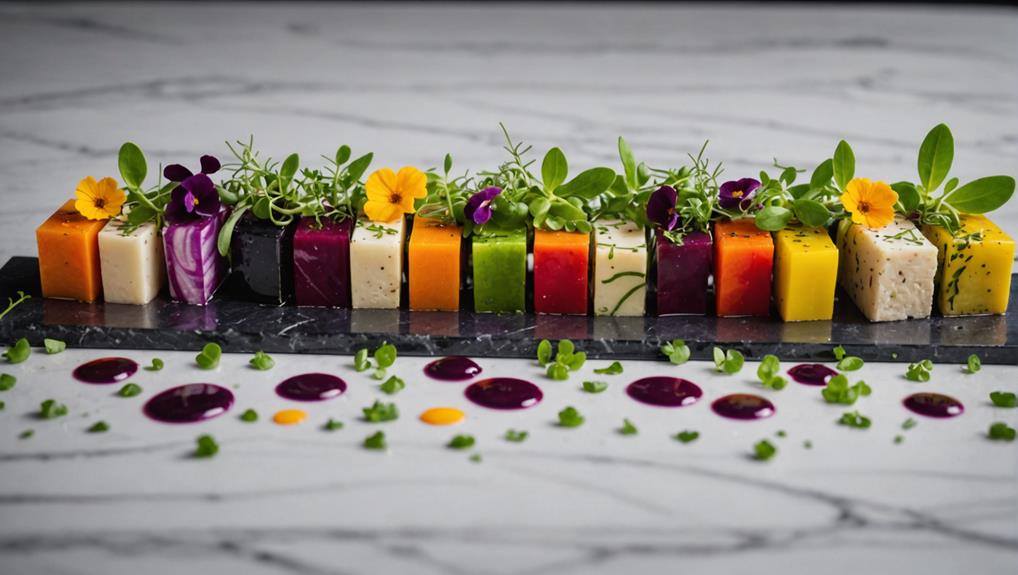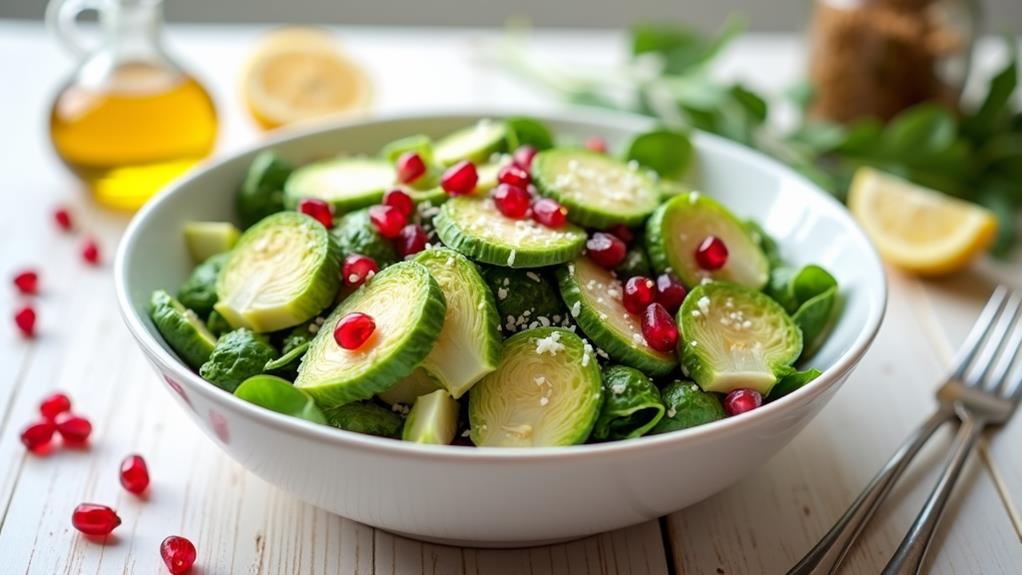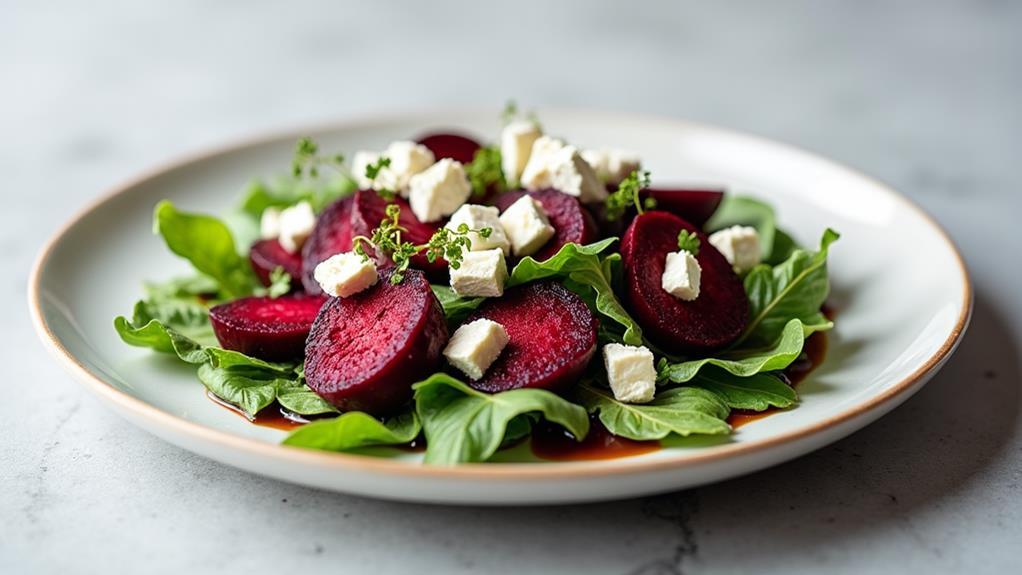To elevate your culinary creations through refined plating, focus on achieving visual balance and creating a compelling focal point. Apply the Rule of Thirds for dynamic compositions, and utilize negative space strategically to highlight key elements. Incorporate contrasting colors and textures to enhance visual interest, while mastering essential garnishing techniques with fresh herbs and edible flowers. Arrange food components purposefully, layering and stacking for depth and dimension. Pay attention to clean plate edges and use precision tools for sauces and garnishes. By combining these principles, you'll transform your dishes into visually stunning masterpieces that captivate diners before they even take their first bite. Exploring these techniques further will unlock endless possibilities for your culinary artistry.
Understanding Plating Principles
Artistry meets culinary expertise in the world of refined plating. To master this skill, you'll need to understand the fundamental principles that guide eye-catching presentations. Plating techniques focus on achieving balance and harmony among colors, textures, and flavors, creating a cohesive presentation that's visually stunning and appetizing.
For instance, incorporating elements like roasted beet salad can bring vibrant colors and unique textures that elevate your dish.
Start by considering the visual appeal of your dish. Utilize contrasting elements, such as vibrant ingredients against neutral backgrounds, to make key components pop. Don't underestimate the power of negative space; it's crucial for allowing individual elements to shine and guiding the diner's eye across the plate.
Experiment with stacking and layering to add depth and dimension to your creations.
As you refine your culinary artistry, remember that consistency in visual flow is key. Guide the diner's gaze intentionally, engaging their interest in exploring the entire dish. This approach not only showcases your creativity but also enhances the overall dining experience.
Mastering Visual Balance
To master visual balance in plating, you'll need to focus on three key elements: color and texture harmony, negative space utilization, and focal point creation.
For instance, when plating a dish like Creamy Spring Greens Rigatoni With Lemon, the vibrant greens from spring vegetables can provide a fresh contrast against the creamy sauce, enhancing visual appeal.
By strategically combining ingredients with complementary colors and diverse textures, you'll create a visually appealing dish that engages the diner's senses.
Incorporate negative space to highlight your main components, and establish a clear focal point to guide the eye, ensuring your plating achieves both balance and impact.
Color and Texture Harmony
Mastering visual balance in culinary presentation requires a keen understanding of color and texture harmony. To create visually appealing dishes that enhance the dining experience, start with color palette selection. Choose 2-3 primary colors that reflect your dish's ingredients, then add accent colors for contrast. When balancing colors, pair bright hues with neutral tones to prevent overwhelming the palate.
Complement this with texture combination, incorporating crunchy, creamy, and silky elements to engage diners' senses fully. For instance, a vibrant dish like Lemon Basil Pasta Salad showcases the interplay of colorful ingredients and textures.
Layering for depth is crucial in showcasing your dish's components. Build height and visual intrigue by strategically arranging ingredients to highlight their unique textures. This technique not only adds dimension but also allows each element to be distinctly appreciated.
Don't forget the power of negative space utilization. By leaving areas of the plate empty, you'll create focus on the dish's essentials and promote visual balance. This approach prevents clutter and allows the colors and textures of your main ingredients to stand out.
Negative Space Utilization
While color and texture harmony create visual interest, the strategic use of negative space elevates your plating to new heights.
By incorporating empty areas around your dish's main components, you'll enhance focus on the food and create a visually appealing balance. This technique guides the diner's eye through the plate, making it more engaging and inviting.
To effectively utilize negative space in your plating:
- Experiment with the balance of filled and empty areas
- Allow for greater appreciation of individual elements
- Prevent overcrowding to maintain visual clarity
- Evoke a sense of elegance and sophistication
Focal Point Creation
At the heart of refined plating lies the art of creating a compelling focal point. To elevate your culinary creations, you'll want to master this essential technique. Start by centering the most visually appealing or flavorful component of your dish, naturally drawing diners' attention and enhancing presentation.
However, don't be afraid to get creative with positioning. Utilize the Rule of Thirds to place your focal point slightly off-center, creating a more dynamic and engaging composition.
To make your focal point truly stand out, employ contrast in colors and textures around it. This strategy ensures complementary elements enhance rather than overshadow the main attraction. Incorporate negative space strategically, allowing your focal point to shine against a clean or limited background.
This approach amplifies its visual impact and creates a sense of sophistication. For added dimension, consider using height or layering techniques. This three-dimensional approach invites diners to explore your dish while maintaining overall balance and harmony.
Exploring Color and Texture Contrasts
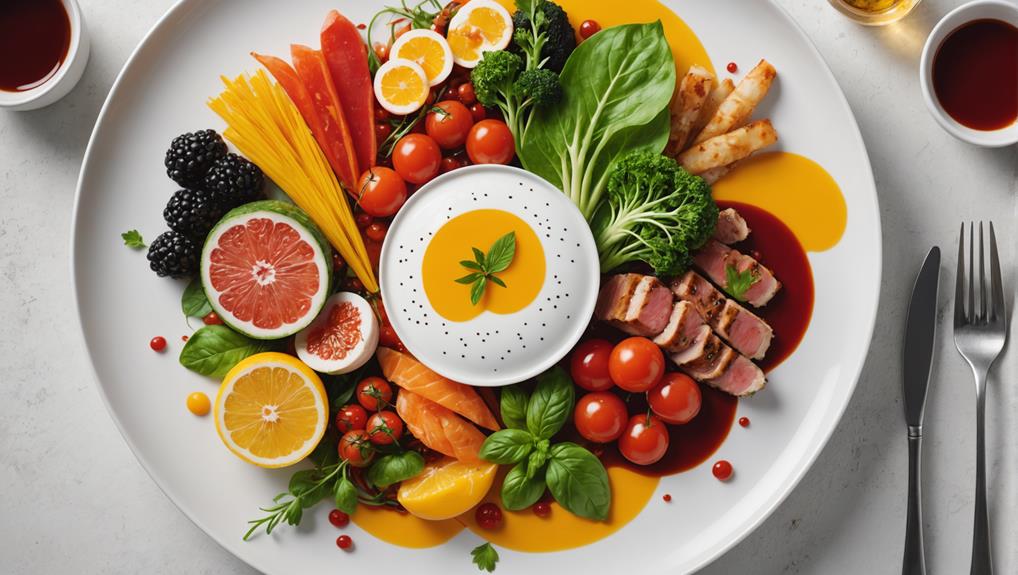
When refining your plating skills, you'll want to explore color and texture contrasts to create visually stunning dishes.
Start by using a color wheel to guide your choices of complementary or contrasting hues, which will enhance visual interest and highlight key components of your dish.
Experiment with various textures, such as pairing crispy elements with smooth sauces, and incorporate different cooking techniques to present a range of textures that will excite both the eye and the palate.
Complementary Color Pairings
A vibrant palette on the plate can transform a meal into a visual masterpiece. When you're plating your culinary creations, consider how complementary color pairings can elevate your dish's appeal.
By strategically positioning contrasting colors, you'll create visual interest that draws the diner's eye and stimulates appetite. To complement the flavors and enhance the overall dining experience, try these innovative color combinations:
- Pair deep reds with vibrant greens for a classic contrast
- Combine warm oranges with cool blues to create excitement
- Juxtapose rich purples against bright yellows for a regal look
- Balance earthy browns with fresh whites for a natural aesthetic
Texture Variety Techniques
Building on the vibrant color pairings, we'll now explore how texture variety can elevate your plating techniques. To create a cohesive and visually appealing dish, it's crucial to incorporate contrasting textures that engage multiple senses. Start by combining different textures, such as pairing crisp vegetables with creamy sauces or tender proteins. This approach not only enhances the overall dining experience but also adds depth and interest to your culinary creations.
Experiment with various cooking methods to achieve diverse textures on the plate. Roasting, frying, and poaching can provide a range of mouthfeels that will intrigue your diners.
Don't forget to utilize crispy elements as garnishes or accompaniments to smooth components. This contrast in textures creates a dynamic tasting experience that will keep your audience engaged.
When plating, consider layering ingredients strategically to highlight texture differences. Stack crispy elements atop softer components to create visual interest and emphasize the unique textures throughout your dish.
Visual Interest Enhancement
To elevate your plating technique, mastering visual interest enhancement through color and texture contrasts is essential.
By utilizing complementary color palettes and strategic textures, you'll create visually stunning dishes that captivate diners' senses. Embrace the power of contrasting elements to draw attention and excite the appetite, transforming each plate into an aesthetically pleasing work of art.
When designing your culinary masterpieces, consider these key aspects:
- Pair creamy elements with crunchy garnishes for textural depth
- Juxtapose smooth purées against roasted nuts for tactile intrigue
- Use vibrant greens and bright reds to convey freshness and seasonality
- Employ negative space to highlight main ingredients
Essential Garnishing Techniques
Mastery of garnishing techniques elevates a dish from ordinary to extraordinary. In the Art of Food Presentation, garnishes play a significant role in bringing your culinary vision to life. To enhance the overall appeal, add a touch of sophistication with fresh herbs, microgreens, and edible flowers. These vibrant elements introduce bursts of color without overwhelming flavors.
Citrus zest and flavored oils can further elevate your dish's aroma and taste profile. When applying garnishes, do so with intention and precision. Carefully place each element to complement the main components while maintaining balance and harmony.
Incorporate various textures, such as crunchy elements or smooth purees, to create a dynamic dining experience that engages the senses. However, be mindful not to overcrowd the plate. Select a few well-placed garnishes that enhance the aesthetic while keeping the focus on the main ingredients.
Arranging Food Components
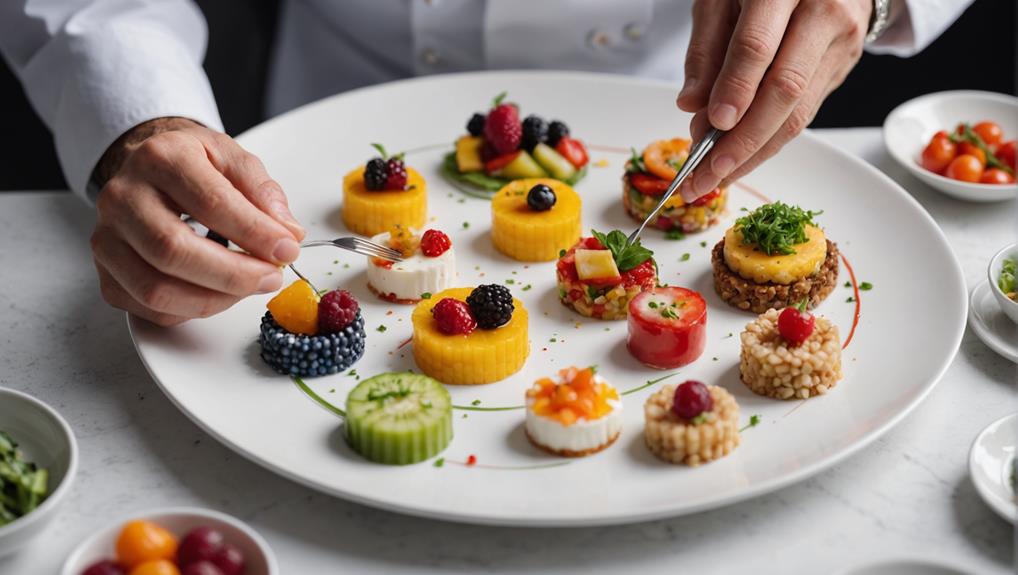
A well-arranged plate is the canvas for your culinary masterpiece. To create a visually appealing presentation, employ the Rule of Thirds to balance flavors and components across the dish.
Establish a focal point by positioning your main protein prominently, guiding the diner's eye through the composition. As you arrange food components, consider the art of plating as a means to elevate your culinary creations.
To add depth and complexity to your plating, consider these innovative techniques:
- Layer and stack elements to create height and dimension
- Incorporate diverse textures for a rich sensory experience
- Utilize negative space to highlight key components
- Experiment with asymmetrical arrangements for a modern touch
Plating With Purpose
Beyond arranging food components, plating with purpose takes your culinary presentation to the next level. It's about understanding how visual appeal influences diners' perceptions of taste and quality. By implementing key principles, you'll create dishes that not only taste great but look stunning too.
Start by applying the Rule of Thirds to balance your composition. This technique guides the eye and enhances enjoyment through thoughtful arrangement. Next, establish a focal point to draw attention to key elements, encouraging diners to fully explore flavors and textures.
Don't overlook the power of negative space; use it intentionally to highlight main ingredients and make them more visually appealing. Colors and textures play a crucial role in refined plating. Carefully select these elements to complement and enhance the flavors of your dish.
This attention to detail results in a more sophisticated culinary experience. Remember, plating with purpose isn't just about making food look pretty; it's about creating a harmonious relationship between visual appeal and taste. By mastering these techniques, you'll elevate your culinary creations and leave a lasting impression on your diners.
Creating Harmonious Compositions
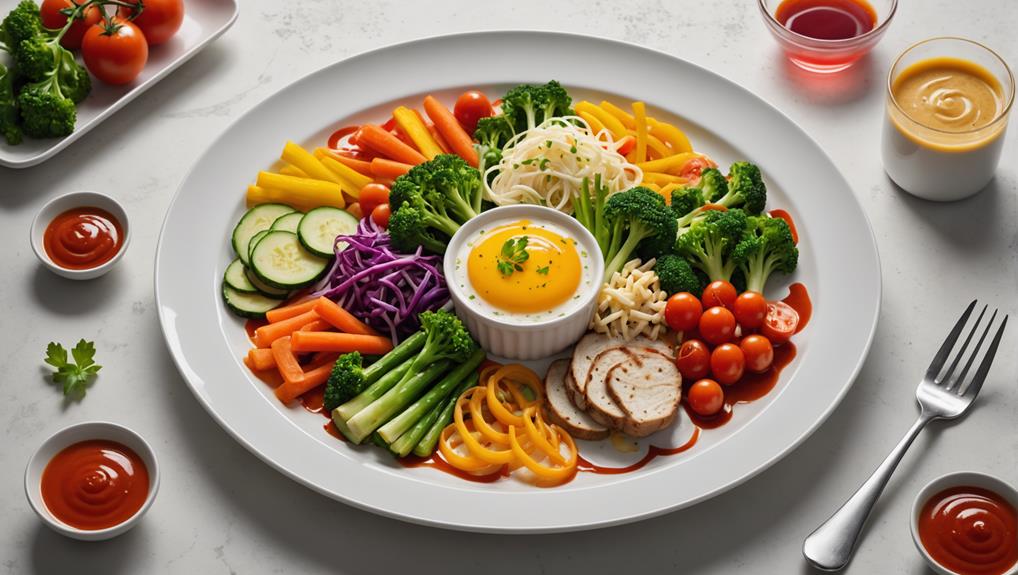
Creating harmonious compositions in plating is an art that balances visual elements to produce a cohesive and appealing dish. To achieve this, you'll need to master the principles of balance, proportion, and contrast.
Start by applying the Rule of Thirds, placing key components at intersections or along dividing lines to create visual interest. Remember, negative space is your ally; it highlights main ingredients and allows the eye to rest, enhancing overall appeal.
When creating visually appealing plates, consider these key elements:
- Balance in plating: Distribute colors, textures, and components evenly
- Textural contrast: Pair crunchy elements with creamy sauces for depth
- Visual composition: Use the Rule of Thirds for harmonious arrangements
- Complementary color schemes: Create visual harmony and grab attention
Incorporate textural contrast to elevate your dish's presentation. This adds depth and intrigue to your visual composition.
Don't shy away from using complementary color schemes; they not only grab attention but also create a visually appealing harmony that enhances the dining experience.
Perfecting Finishing Touches
The devil's in the details when it comes to perfecting finishing touches in refined plating. To elevate your culinary creations, you'll need to focus on the minute elements that transform a dish from ordinary to extraordinary.
Start by ensuring clean plate edges, a crucial aspect that instantly enhances visual appeal and conveys professionalism. Utilize plating tools like squeeze bottles or offset spatulas to apply sauces or garnishes with precision, creating a polished look that captivates diners.
Temperature control is vital; serve your dishes at the optimal temperature to maintain both flavor and aesthetic appeal. Remember, timing is everything. Assemble and plate your creations just before serving to preserve the freshness and visual impact of each component.
To add a unique touch, consider incorporating flavored oils or bespoke garnishes that reflect your culinary identity. These finishing touches not only elevate the dining experience but also make your dishes memorable.
Frequently Asked Questions
What Is Plating in Culinary Arts?
Plating in culinary arts is your canvas for creativity. You'll use innovative techniques to craft visually stunning dishes, balancing colors, textures, and cultural influences. Your ingredient arrangement and composition skills will elevate the dining experience to new heights.
What Are the Plating Trends for 2024?
A canvas of innovation awaits you in 2024. You'll embrace vibrant colors, asymmetrical balance, and edible flowers. Rustic elements and texture contrasts will shine. Cultural influences and minimalist design will elevate your plates to new heights.
What Are Two Key Points for Attractive Plating?
You'll elevate your plating game by mastering color contrast and texture balance. Choose plates that complement your dish, and perfect your garnishing techniques. Don't forget to play with portion sizing, sauce application, and visual height for maximum impact.
How Do You Make Plating Look Good?
Paint your plate like a canvas! Master plating techniques, embrace color contrast, and balance textures. Choose the right plate, control portions, and explore creative garnishing ideas. You'll create visual harmony that'll make diners' eyes dance with delight.
Final Thoughts
You've now explored the art of refined plating, but does it truly elevate your culinary creations? The evidence suggests it does. By applying these principles, you'll transform ordinary dishes into visually stunning masterpieces that engage all the senses. Remember, plating isn't just about aesthetics; it's about enhancing the dining experience. As you practice, you'll develop your unique style, turning each plate into a canvas for your culinary vision. Keep experimenting, refining, and most importantly, enjoying the process of creative plating.

